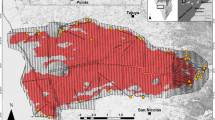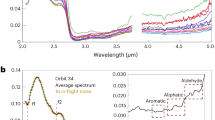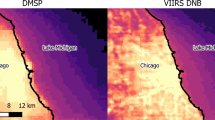Abstract
THE uranian satellite UmbriePs dark, heavily cratered surface is remarkable for its apparent uniformity in Voyager II images1. Its most conspicuous geological feature is a comparatively high-albedo, annulus-shaped deposit which covers the floor of the 40-km diameter crater Wunda1. Here we present new Voyager II albedo maps of Umbriel which reveal that its surface is subdivided into low-contrast, crudely polygonal areas ranging in size from tens to hundreds of kilometres (Fig. 1). The largest polygons are elongate with systematically trending northeast–southwest boundaries. Some of the polygonal areas form topographic depressions several kilometres in depth. We suggest that this newly discovered global albedo pattern is a relic of the early tectonic disruption of Umbriel's surface.
This is a preview of subscription content, access via your institution
Access options
Subscribe to this journal
Receive 51 print issues and online access
$199.00 per year
only $3.90 per issue
Buy this article
- Purchase on Springer Link
- Instant access to full article PDF
Prices may be subject to local taxes which are calculated during checkout
Similar content being viewed by others
References
Smith, B. A. et al. Science 233, 43–64 (1986).
Hapke, B. W. J. geophys. Res. 86, 3039–3054 (1981).
Hapke, B. W. Icarus 59, 41–59 (1984).
Hapke, B. W. Icarus 67, 264–280 (1986).
Helfenstein, P., Veverka, J. & Thomas, P. C. Icarus 74, 231–239 (1988).
Helfenstein, P. & Veverka, J. Icarus 72, 342–357 (1987).
Thomas, P. C. Icarus 73, 427–441 (1988).
Strom, R. G. Icarus 70, 517–535 (1987).
Author information
Authors and Affiliations
Rights and permissions
About this article
Cite this article
Helfenstein, P., Thomas, P. & Veverka, J. Evidence from Voyager II photometry for early resurfacing of Umbriel. Nature 338, 324–326 (1989). https://doi.org/10.1038/338324a0
Received:
Accepted:
Issue Date:
DOI: https://doi.org/10.1038/338324a0
This article is cited by
-
Characteristics of Icy Surfaces
Space Science Reviews (2010)
Comments
By submitting a comment you agree to abide by our Terms and Community Guidelines. If you find something abusive or that does not comply with our terms or guidelines please flag it as inappropriate.



